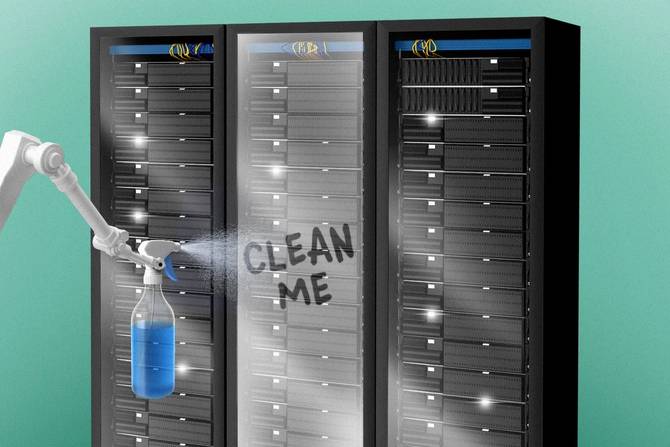Wednesday has arrived. If you’re thinking of joining the Great Resignation and quitting your job, it would be gauche to make a big scene about it. So, why not do it quietly? Wait, what do you mean that’s worse?!
In today’s edition:
 Hidden costs Hidden costs
 Devilish design Devilish design
—Tom McKay, Billy Hurley, Patrick Lucas Austin
|
|
Just_super/Getty Images
You’d think that the payment would be the most significant aspect of a ransomware attack—especially given that the average paid ransom in 2021 was just over $800,000.
And, hey, ransom’s in the name…
But a survey of 300 ransomware victims discovered that other factors hit harder than the ransom: lost productivity, increased downtime, and ruined reputations. The GetApp poll found that, among respondent companies that paid up, only 11% considered the sum to be the most consequential impact—a fact that didn’t surprise incident-response professionals who spoke with IT Brew.
The “easy” part. Responding to a ransomware attack has financial costs: You’ll likely need to pay your recovery team of security providers, outside counsel, and negotiations specialists.
“Sometimes, the payment’s the easiest thing to do, if it’s possible from a legal perspective, because the other costs for that whole ecosystem may outweigh what the bad actor is asking for, in terms of a payment,” said Jess Burn, senior analyst at Forrester.
Paying up in downtime. 34% of the companies surveyed by GetApp that did not pay a ransom still incurred damages above $50,000, which included factors like device replacement and downtime.
“The extortion is maybe 10% of the overall costs,” said Dave Wong, VP at Mandiant, citing legal fees, data recovery, and productivity loss.
“The financial aspect of it doesn’t even describe how impactful it is for most organizations, because it’s very disruptive. You’re running a business, and then all of the sudden, a lot of things stop,” Wong told IT Brew.
Read the rest here.—BH
Do you work in IT or have information about your IT department you want to share? Email [email protected] or DM @BillyHurls on Twitter.
|
|
|
Is the shift to a hybrid work environment creating friction with your employees? Let Robin show you how to create a hybrid workplace that actually works.
Navigating this post-pandemic world can be confusing. To keep your team engaged and optimistic, set clear expectations. Give employees a detailed explanation of how your company’s hybrid model will function, including the remote tools they’ll use to stay connected.
Robin’s Hybrid Work 101 guide has the plan you need to foster community and connection whether you’re in the office or at home. You’ll find free templates for workplace strategy, learn about tech resources, and get advice on being a successful leader.
Ready for a new and improved workplace? Get your guide here.
|
|
Francis Scialabba
A new form of side-channel attack can use hard drive cables to turn a computer into the digital equivalent of a numbers station, according to research published in July by researcher Mordechai Guri at Ben-Gurion University of the Negev, Israel.
Side channels are potential information pathways indirectly generated by the operation of a computer system—everything from the sounds of keyboards and internal components to leaking electromagnetic radiation and power-monitoring data. Creative attackers can exploit these side channels to exfiltrate information from a system they can’t otherwise access directly, such as air-gapped networks that do not directly communicate with external systems.
One method of side-channel attack is to turn existing computer hardware into a transmitter. For example, in 2020, security firm Duo manipulated the clock rates of Radeon graphics cards to turn GPUs into radios capable of transmitting up to 50 feet away. Guri’s method, dubbed “SATAn,” converts the ubiquitous SATA cable into a radio antenna operating in the 6 GHz frequency band. A system thus subverted is capable of transmitting at 1-bit-per-second over a distance of approximately one meter.
But, it’s pretty niche. No hardware modifications are required; the SATAn exploit uses shellcode to manipulate file-system activity, generating a radio signal via the electromagnetic leakage from the SATA cable. Placing it on an air-gapped system, Guri wrote, might require advanced techniques such as “supply chain attacks, removable media attacks, malicious insiders, and deceived employees to breach the network.”
Then the attacker would need a way to place a receiver close by. Guri’s method was a USB software-defined radio plugged into a laptop—a pretty specific piece of equipment to plop down near a secure system—but as he noted in the paper, “a hardware receiver might be hidden or implanted” in any number of devices, like servers.
Read more here.—TM
Do you work in IT or have information about your IT department you want to share? Email [email protected] or DM @thetomzone on Twitter. Want to go encrypted? Ask Tom for his Signal.
|
|
TOGETHER WITH AWS MARKETPLACE
|
|
Guide: DevSecOps for cloud-native applications. Introducing security earlier in development creates a DevSecOps model that enables continuous innovation while mitigating risk and compliance. Join this webinar to learn the importance of application security scanning, infrastructure as code (IaC) security scanning, testing practices and patterns, and how to apply policy and compliance guardrails. Register now.
|
|
|
Managing IT teams can be a challenge. Go beyond the project management certification alphabet soup to learn what it takes to be a successful leader in today’s business environment. The Brew’s Leadership Accelerator starts in September—apply today!
|
|
Francis Scialabba
Today’s top IT reads.
Stat: 120,000. That’s the number of Barclays “colleagues and service partners” replacing their collaboration tools with Microsoft Teams, per an agreement between the two companies. (Microsoft)
Quote: “We have confirmed that no Cloudflare systems were compromised.”—Network-security company Cloudflare, addressing an unsuccessful phishing attack that was thwarted due to the use of physical security keys (ITPro)
Read: Gene-editing startup Colossal is using CRISPR to attempt to “de-extinct” Australia’s Tasmanian tiger. (CNET)
IT’ll cost ya: But with Electric’s free IT cost calculator, you can get an estimate of the time and money your biz spends on IT-related tasks. Not crazy about your result? Electric can save you 50% on IT costs with their lightning-fast support. Calculate here.*
*This is sponsored advertising content.
|
|
-
NASA is sending a satellite containing yeast into deep space to study the effects of radiation on living cells.
-
Google is releasing its Android 13 software update this week, and it’s hitting the company’s Pixel smartphones first.
-
Apple is gearing up for another RTO push, this time asking employees to come into the office three times a week by September.
-
A UK water supplier was the victim of a ransomware attack, though its attackers may have been aiming at a different, larger UK water supplier.
|
|
|







